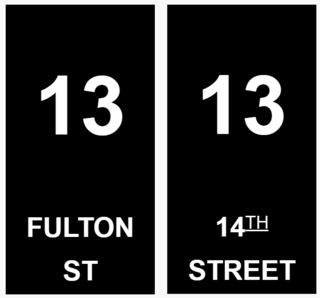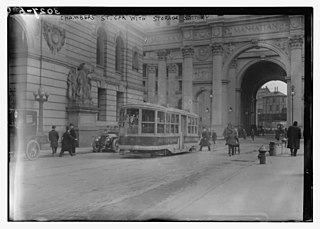The New York and Harlem Railroad was one of the first railroads in the United States, and was the world's first street railway. Designed by John Stephenson, it was opened in stages between 1832 and 1852 between Lower Manhattan Island to and beyond Harlem. Horses initially pulled railway carriages, followed by a conversion to steam engines, then on to battery-powered Julien electric traction cars. In 1907, the then leaseholders of the line, New York City Railway, a streetcar operator, went into receivership. Following a further receivership in 1932, the New York Railways Corporation converted the line to bus operation. The Murray Hill Tunnel now carries a lane of road traffic, but not the buses.

13 was the BMT's designation for service on the BMT Fulton Street Line, not to be confused with today's IND Fulton Street Line, which uses a portion of the old BMT line at its east end.
The Forty-second Street and Grand Street Ferry Railroad was a horse-drawn streetcar line in Manhattan, New York City, United States. It ran from the 42nd Street Ferry on the Hudson River to the Grand Street Ferry on the East River. The line was distinguished by a light green light.
Fulton Ferry may refer to:

The Atlantic Avenue Railroad was a company in the U.S. state of New York, with a main line connecting downtown Brooklyn with Jamaica along Atlantic Avenue. It was largely a streetcar company that operated its own trains, but the Long Island Rail Road operated both streetcars and steam trains over its main line. It later became part of the Nassau Electric Railroad, but is now divided between the active Atlantic Branch of the LIRR and the unused Cobble Hill Tunnel, which is preserved in its original state, albeit without service tracks.
The Culver Line, Gravesend Avenue Line, or McDonald Avenue Line was a surface public transit line in Brooklyn, New York City, United States, running along McDonald Avenue and built by the Prospect Park and Coney Island Railroad. Most of its main line has been essentially replaced by the IND Culver Line of the New York City Subway.

The Third Avenue Railway System (TARS), founded 1852, was a streetcar system serving the New York City boroughs of Manhattan and the Bronx along with lower Westchester County. For a brief period of time, TARS also operated the Steinway Lines in Long Island City.

The Ninth and Tenth Avenues Line or Ninth Avenue Line is a surface transit line in the New York City borough of Manhattan, running mostly along Ninth Avenue and Amsterdam Avenue from Lower Manhattan to Manhattanville. Originally a streetcar line operated by the Manhattan and Bronx Surface Transit Operating Authority, it is now the M11 bus route operated by the New York City Transit Authority.
The Houston, West Street and Pavonia Ferry Railroad was a street railway company in the U.S. state of New York. It owned and operated a system in Lower Manhattan, and became part of the Metropolitan Street Railway.
The 17th and 18th Streets Crosstown Line was a public transit line in Manhattan, New York City, United States, running mostly along 14th Street, 17th Street, and 18th Street from the West 14th Street Ferry in Chelsea and Christopher Street Ferry in the West Village to the East 23rd Street Ferry at Peter Cooper Village. It was not replaced with a trolley line or bus route when it was abandoned in 1913.

The M9 is a local bus route that operates along the Avenue C Line, in Manhattan, New York City. The M9 and M21 are operated by the New York City Transit Authority, and based out of the Michael J. Quill Depot.

The New York Railways Company operated street railways in Manhattan, New York City, between 1911 and 1925. The company went into receivership in 1919 and control was passed to the New York Railways Corporation in 1925 after which all of its remaining lines were replaced with bus routes.
The Brooklyn and North River Line, operated by the Brooklyn and North River Railroad, was a trolley line in Manhattan and Brooklyn, New York City, United States. Its route ran from the Desbrosses Street Ferry across Lower Manhattan via the Canal Street Crosstown Line, over a pair of tracks on the east side of the Manhattan Bridge, and to the intersection of Flatbush Avenue and Fulton Street in Downtown Brooklyn. Operation in Manhattan and over the bridge was with conduit electrification, while in Brooklyn it used overhead trolley wire, switching at a plow pit.
The Seventh Avenue Line is a surface public transit line in Manhattan, New York City, United States, connecting Lower Manhattan with Central Park along Seventh Avenue. Once a streetcar line, it is now part of the southbound direction of the M10 and M20 bus routes.

The West End Line or New Utrecht Avenue Line was a surface transit line in Brooklyn, New York City, United States, running along New Utrecht Avenue and other streets between Coney Island and Sunset Park. Built by the Brooklyn, Bath and Coney Island Railroad as a steam line, it became a trolley line, along which elevated trains ran until the new elevated BMT West End Line opened. This route is no longer part of any bus line; its southern part was part of a bus route. In 2013, the B64 route to Coney Island was restored.

The Manhattan Bridge Three Cent Line was a streetcar company that operated cars over the Manhattan Bridge between the boroughs of Brooklyn and Manhattan in New York City. As the name implied, the fare was only 3 cents per ride.

The 86th Street Crosstown Line is a bus line in Manhattan, New York City, running mostly along 86th Street on the Upper West and Upper East Sides of Manhattan. Originally a streetcar line, it now comprises the M86 Select Bus Service bus line.








